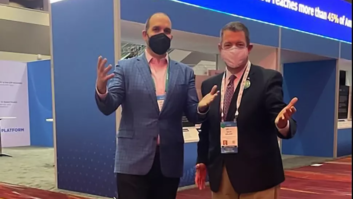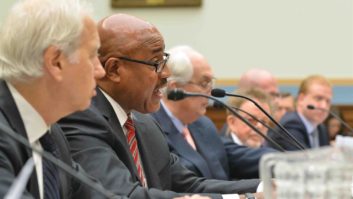A corporation like XM Satellite Radio depends on its image as a cutting-edge home for the arts to attract performers, investors, directors and potential employees. It’s a given that broadcast equipment must be pristine and appear high-tech.
In today’s world of revolving-door technology, the extra “wow” factor is essential for such a company to make an impression with visitors to its facilities.
Transparent screens float in front of the two XM engineers’ consoles at the JAZZ station in Lincoln Center in Manhattan, allowing the technicians interactively to select any item desired on their display while taking up zero topographical real estate. The screens hang in mid-air. The result is a futuristic, somewhat holographic display, with clear, sharp full-color images seeming to appear out of thin air.
XM Satellite Radio has On Location Visuals and Zandar Technologies to thank for this element of its “wow” factor.
In a project designed, installed and managed by systems integrator On Location Visuals, Zandar MultiViewers are employed at several XM locations to render multiple sources to high-resolution displays.
(click thumbnail)Zandar’s FusionPro projects a musical performance onto a transparent screen from On Location Visuals in the XM Satellite Radio lobby in Washington.Two systems are installed in front of DJ booths at the JAZZ station at Lincoln Center in New York; another unit drives the display in the lobby of XM’s Washington headquarters, with a further system scheduled for installation in the control room area.
Zandar has developed a processor that permits multisource images to be projected onto suspended translucent screens provided by On Location Visuals, addressing display, monitoring and surveillance needs. Capable of four processing cards and supporting up to eight scalable windows at SXGA+ (1,400 x 1,050 pixels), the FusionPro MultiViewer, according to Zandar, uses a combination of 10-bit RGB outputs, an advanced video processing engine and dynamic phase adjustment for accurate pixel mapping to feed a Canon Realis SX50 projector.
FusionPro is built on modular architecture consisting of a choice of plug-in processing cards and associated I/O, enabling users to combine formats – analog, video, SDI, HD-SDI, RGBHV computer sources, DVI sources and audio – in one system.
Take out the seams
At the Washington headquarters of XM Satellite Radio, I met with Terry Carr, manager of broadcast applications, who showed me several functioning Zandar displays. Four Zandar FusionPro 1 RU MultiViewers are employed at numerous locations to provide digital signage or full-color graphic images of the inner workings of the facility that include a mix of live and prerecorded video, audio and computer signals, as well as impress guests brought in to the facility.
The images were engaging; while at times there were as many as four activities taking place on the single screen, they were not separated by the familiar black lines used to frame each one, as with the familiar “picture-in-picture” technology. They maintained their own spaces and were separated seamlessly.
Then Carr took me into the “ECC,” XM’s version of Master Control. In the rear of the room was a curved wall filled with six 32-inch (diagonal) CRT television screens across by two 32-inch TVs high, all told measuring 200 inches wide by 68 inches high. Carr said Zandar was designing additional equipment for FusionPro to project images onto a single screen built to that size, which not only will look unique – as there will be a seamless picture, which is not possible with conventional televisions – but will provide substantially more coherent visual information.
(click thumbnail)XM Manager of Broadcast Applications Terry Carr.It also will reduce the demands on air conditioning in the room, as the heat given off by the CRT electronics will disappear. Zandar Technologies has named this optional facility ZdH Zandar Dual Head Display, and says it will provide cost savings to users worldwide.
On the big screen
MultiViewers permit diverse inputs for display on a single large screen, replacing the traditional monitor stack with a virtual monitor wall. The ZdH-enabled MultiViewers combine support for multiple inputs, of any format and in any combination, with the ability to drive two displays on one monitor wall, seamlessly connected and simple to control. Any of the inputs (up to 26 on the FusionPro+), can be viewed on either display, including horizontally spanning the displays.
Additionally, ZdH provides device redundancy. In the event of failure of one display projector, the operator instantly can reroute channels to the remaining active display by recalling a preloaded recovery configuration. This product is for mission-critical applications in Master Control rooms and Network Operation Centers.
With the Zandar MultiViewers, a director can sit in front of a monitor on the studio floor and simultaneously see the output of three sources as well as the program output of the mixer. The unit outputs a quad split-type display with each quadrant displaying the key images desired. This also allows for accurate side-by-side comparisons of before and after post-production effects.
Another value is apparent when one considers, for example, a 40-inch LCD typically costs more than six times a 20-inch LCD. Zandar’s ZdH technology allows one to quarter a portrait display and then project it seamlessly onto four 20-inch panels, accomplishing the desired large image while reducing capital equipment cost.
The range of resolutions supported using ZdH includes the popular plasma, LCD and projection system resolutions. ZdH is enabled via software license and can be factory installed or provided as a field upgrade.
The Zandar Remote Panel is a desktop control pad that provides the user with push-button control of one or more Zandar MultiViewers. The panel can control up to 100 serially attached units, including FusionPro, Predator, DX and MX Series MultiViewers.
Mark Greenhouse runs Tactical Productions. He is a broadcast/recording engineer with NPR in Washington. Reach him at [email protected].














